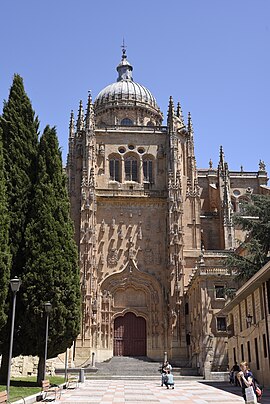Plateresque
It reached its peak during the reign of Charles V, Holy Roman Emperor,[2] especially in Salamanca, but also flourished in other such cities of the Iberian Peninsula as León, Burgos, Santiago de Compostela, also in the territory of New Spain, which is now Mexico, and in Bogotá.
[5] The style is characterized by ornate decorative façades covered with floral designs, chandeliers, festoons, fantastic creatures and all sorts of configurations.
But by the mid-20th century this geographical connotation was questioned under the arguments of several authors, especially Camón Aznar (1945) and Rosenthal (1958), who defined Plateresque generically as a unitary amalgam of elements – Gothic, Muslim, and Renaissance.
Aznar does not regard it as a style properly denoted as Renaissance, and Rosenthal emphasizes its association with certain buildings in other European countries, mainly France and Portugal, but also Germany and others.
[3][5][8] This problem highlights the imprecision of the name Plateresque and the difficulties inherent in using it to describe productions from a period of confusion and transition between styles, especially since they are characterized by decorative profusion suggesting an attempt to disguise the failure of Spanish architects to develop new structural and spatial ideas.
It has even been suggested that this problem could be solved by identifying what is called Plateresque as the replacement of Gothic decoration with grotesques inspired by the works of the Italian Sebastiano Serlio.
[9] Any persuasive argument, however, must admit that the Plateresque or Protorenaissance was an artistic movement that responded to the demands of the ruling classes of imperial Spain, which had just completed the Reconquista and begun the colonization of the Americas.
The Spanish were developing a consciousness of their growing power and wealth, and in their exuberance launched a period of construction of grand monuments to symbolize these with what are now considered national treasures.
There is evidence of more polychrome works at the conclusion of the first third of the 16th century, when there appeared heraldic crests of historical provenance and long balustrades, to mention one kind of less busy decoration.
[11] Although the appellation 'Plateresque' is usually applied to the act of superimposing new Renaissance elements on forms governed by medieval guidelines in architecture, this trend is also seen in the Spanish painting and sculpture of the time.
That event occurred with the amendments by Juan de Herrera and Philip II of Spain to the design of the monastery of El Escorial, whose construction began in 1563.
Bertram Goodhue and Carleton Winslow Sr. studied Spanish Colonial structures in Mexico before designing the 1915 Panama–California Exposition in San Diego, California, that introduced this style to the United States and subsequent widespread popularity.










